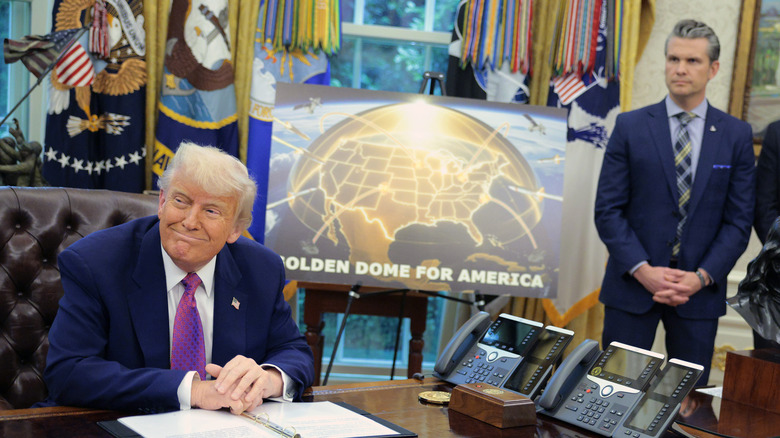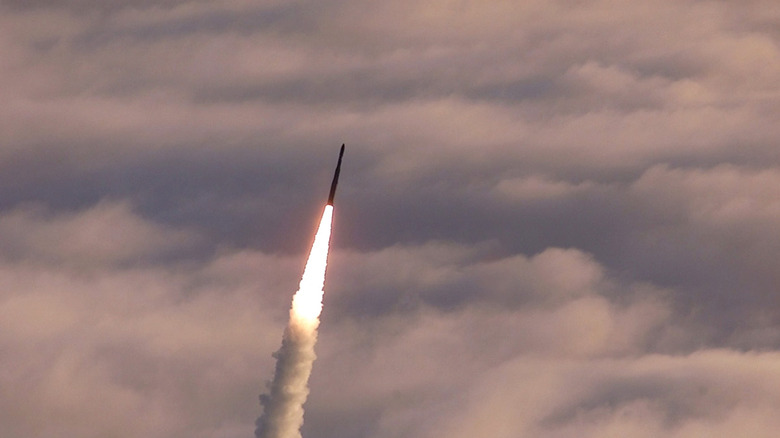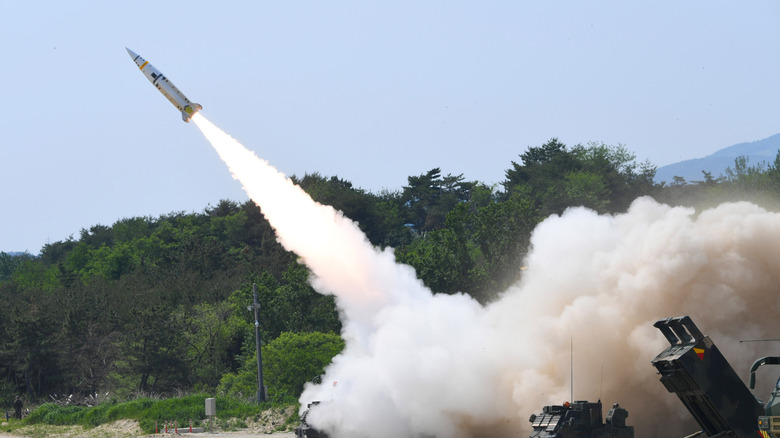
In May 2025, President Trump selected a format for pursuing his long-sought Golden Dome, a missile defense system resembling Israel's Iron Dome. The program, which the White House officially ordered the Pentagon to begin developing in January 2025, will be a multilayered system involving land, sea, and space-based missile interceptors, constituting the first time that U.S. military weapons will be stationed in the final frontier. The system will ward off threats at all four stages of missile attacks,
hitting them at the launch point, intercepting the warhead during its early flight, mid-course, and its final descent towards a target.
This system will reportedly address all major missile threats, ranging from ballistic missile systems to land attack cruise missiles and even, according to the president, attacks that originate in space. The United States' desire for a space-driven missile defense system harkens back to 1983, when Ronald Reagan pitched the Strategic Defense Initiative. Derisively known as Star Wars, the initiative sought to solve the nuclear arms race through a then-unfeasible space-based missile defense layer.
Although the Cold War project was met with widespread pushback from within and outside the U.S., the country seems poised to move forward with the modern proposal, despite several questions remaining regarding its viability, costs, and geopolitical consequences. Aiming to be operational by the end of President Trump's final term, the Pentagon is on the precipice of embarking on a missile program that its project head, Space Force General Michael Guetlein (via SpaceNews), dubbed "on the magnitude of the Manhattan Project."
Read more: 10 Terrifying War Drones That Give Us Chills
Before The Dome

Rather than build from scratch, the Golden Dome will graft additional layers onto America's existing ground-based interceptor program. Deployed at Fort Greely and Vandenberg Air Force Base in Alaska and California, respectively, the U.S. deploys 44 silo-launched three-stage rockets that use radar updates and infrared sensors to direct an exoatmospheric kill vehicle to strike oncoming ballistic missiles mid-course. Both the Biden and Trump administrations invested in the ground-based program.
Prior to the Golden Dome initiative, 20 Next-Generation Interceptors and a third East Coast launch site were scheduled to be added in 2028 and 2031, respectively. In addition to these ground-based defenses, the U.S. deploys a series of mobile missile defense units. The largest is its naval Aegis ballistic missile defense program, in which 56 American cruisers and destroyers are equipped with radars and interceptor missiles to disrupt short, medium, and intermediate-range ballistic missiles midcourse, largely in Asia and Europe. As it stands, the United States plans to equip 13 more ships with Aegis-BMD capabilities by 2030.
For the final stage of a missile's flight, the U.S. military and its allies use truck-mounted Terminal High Altitude Area Defense (THAAD) rocket launchers and mobile launch-mounted Patriot Advanced Capability-3 rockets. According to a July 2025 report by the Guardian, the U.S. only possesses 25% of the Patriot missile stockpile needed for its armament goals. Despite this architecture, the gap between America's current missile defenses and foreign attack capabilities is daunting. The U.S. Ballistic Missile Defense system is only designed to counter missile threats targeting foreign bases and allies. It's not capable of defending against homeland-targeted attacks.
How The Golden Dome Will Work

The Golden Dome will seek to expand the size and complexity of these defense systems, creating a multi-layered defense equipped with space-based interceptors and non-kinetic capabilities -- such as lasers -- to identify, track, and target potential threats at every stage between launch and impact. The easiest way to understand this system is to break it up into its two primary functions: detecting and neutralizing threats. To accomplish the former, General Gregory Guillot, head of U.S. Northern Command, stressed to Congress the need for a domain awareness layer, taking a "seabed-to-space approach" to identify potential threats on a global level. This will be a massive undertaking that will likely combine satellites, undersea sensors, airborne target tracking planes, and ground-based radar to cover the full scope of potential attack vectors, from silos to submarines.
What this system might look like is fiercely contested, with critics noting both the gargantuan size of the constellation and the difficulty of coordinating systems that require seamless, rapid responses. To solve this issue, some have controversially advocated for the Pentagon to subscribe to surveillance satellites provided by private sector companies. Possible candidates include SpaceX, Anduril, and Palantir.
In addition to this surveillance architecture, the U.S. would likely deploy a layer of attack satellites utilizing interceptor missiles and directed-energy weapons. This would potentially give the U.S. several major advantages, including the capacity to intercept missiles during their boost phase, either during or shortly after launch. Experts note that this is the easiest time to target ballistic and hypersonic missiles, as it is not only the slowest and most predictable portion of their flight path but is also before they can deploy evasion maneuvers.
Where Things Stand

The Trump administration has taken several steps toward meeting its three-year target. Following the January 2025 executive order, the Pentagon drafted an action plan for the system, culminating in the $175 billion architecture selected by the president in May. The project is to be headed by the Space Force's vice chief of space operations, General Michael Guetlein, a staunch advocate for a proactive military space presence.
The total funding for the Golden Dome, however, is uncertain. While the selected program calls for $175b, Congress's current funding is well below this number, with a preliminary $24.4 billion earmarked in the recent budget bill. Whether Congress will provide the additional $150 billion over the next three years is all but a foregone conclusion, as many lawmakers remain skeptical about the program's costs and feasibility.
Much of the private sector is understandably bullish on the project, with several defense contractors and tech giants expected to lobby for roles in the initiative, ranging from defense firms like Lockheed Martin, Boeing, and Northrop Grumman to Silicon Valley powers like Microsoft and Palantir. The role of SpaceX has already become a major sticking point for advocates and critics alike, amidst CEO Elon Musk's unsteady relationship with the president. As the world's largest satellite provider, SpaceX's involvement could determine the practicality of President Trump's end-of-term timeline.
Questions Remain

The Golden Dome hinges on the U.S. rapidly scaling its satellite constellations at an unprecedented rate. How many satellites it will require, however, is hotly debated. For instance, there are estimates that the U.S. would need a constellation of 16,000 to intercept a salvo of just 10 intercontinental ballistic missiles. For reference, SpaceX operates less than half of that number. Another estimate found that the system could start with 2,000 dual-purpose satellites. Complicating the count is the need for annual replacements of these satellites.
Then there's questions of intercepting the missiles themselves. As missile technology has advanced, detecting, tracking, and intercepting hypersonic intercontinental ballistic missiles has become increasingly difficult, necessitating an ever-widening technological and logistical network. To target ballistic missiles in their boost phase, the U.S. will need to collect, manage, and act on unprecedented amounts of data within minutes.
Questions also remain about the program's costs. The Congressional Budget Office, for example, stated that the space-based portions alone would cost $542 billion over the next two decades, more than three times the president's projection and double America's collective missile defense spending since 1985. This number is conservative, since it's based on the infrastructure necessary to defend against lesser nuclear powers, rather than the peers the Golden Dome hopes to counter. According to the CBO, the total number could climb to a whopping $831 billion, and some expect it to exceed one trillion. This is in addition to the CBO's $946 billion projected 10-year costs for upgrading and maintaining America's nuclear arsenal.
Escalating The Arms Race

Beyond these concerns lies an existential question: Will the Golden Dome make the United States safer? For some experts, the project undermines the logic of nuclear deterrence and escalates the global arms race, likely prompting U.S. rivals to upgrade their arsenals. This is what happened when Russia installed over 100 missile interceptors during the Cold War and the U.S. responded by bolstering its Russia-trained arsenal. Likewise, Russia initiated new missile development programs to defeat Reagan's SDI program. China and Russia have jointly condemned the Golden Dome project.
This new arms race, however, might already be in full swing, as Beijing started testing dogfighting satellites in March 2025. Russia, for its part, has been accused of building a nuclear weapon to target satellite networks since 2024. Some scientists are concerned about the dome's effectiveness against these more advanced attacks, particularly those with countermeasures. As such, the question may not be whether the Golden Dome sparks an arms race, but whether it can keep up with the evolving challenges it accelerates.
Another question is how the dome affects U.S. allies. According to officials, Canada will need to provide airspace and radars to track and identify missile launches. President Trump, meanwhile, has downplayed Canada's role, and instead offered a $61 billion deal to join the project. While many Canadians are skeptical, Canadian Prime Minister Markey Carney had 'high-level talks' about the initiative in May 2025. Even if Canada joins the program, an arms race could endanger the 30 European NATO allies protected under Article 10 , leaving them underequipped for a new age of missile defense and further complicating the geopolitical calculus.
Want the latest in tech and auto trends? Subscribe to our free newsletter for the latest headlines, expert guides, and how-to tips, one email at a time.
Read the original article on SlashGear.













